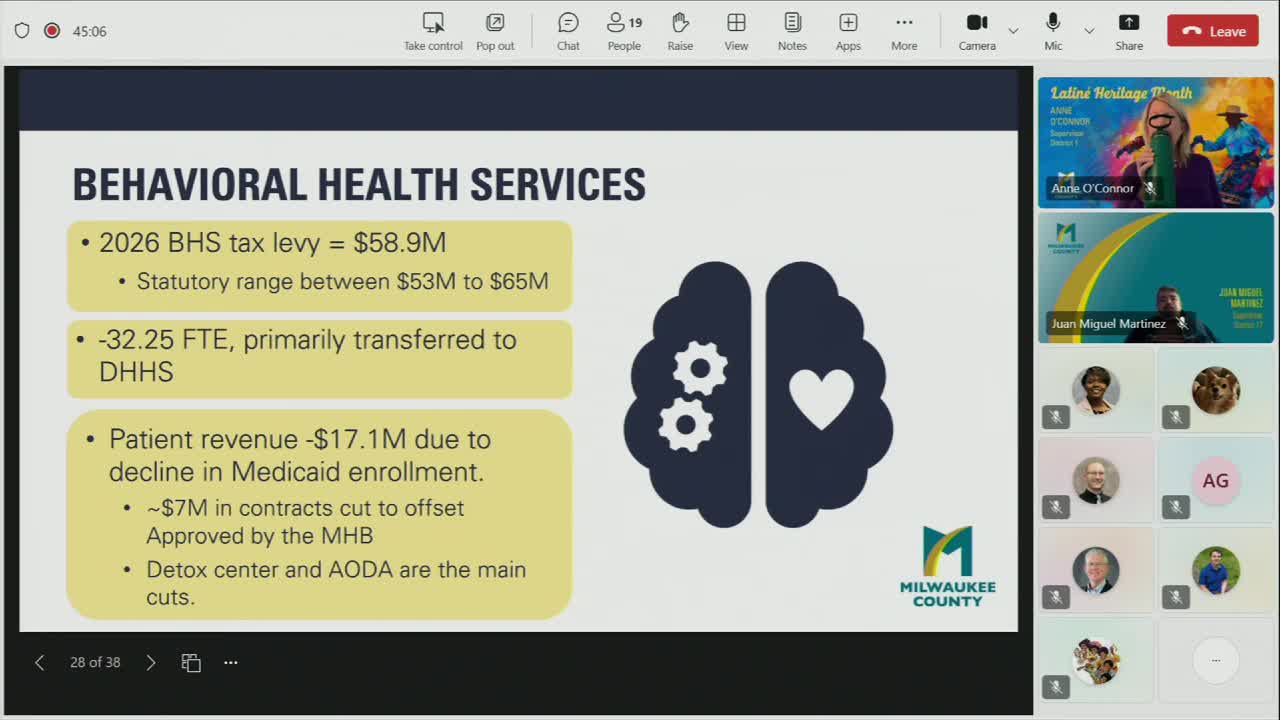County proposes 1% pay increase, changes to pensions and health benefits including spousal surcharge
October 09, 2025 | Milwaukee County, Wisconsin
This article was created by AI summarizing key points discussed. AI makes mistakes, so for full details and context, please refer to the video of the full meeting. Please report any errors so we can fix them. Report an error »

Milwaukee County staff told the Committee on Finance that the recommended 2026 budget includes modest employee compensation increases but also several benefit design changes that together alter take-home pay for many county workers.
The recommended budget assumes a 1% general salary increase for most employees in 2026. Staff said the Milwaukee County Employee Retirement System (ERS) employee contribution rate would drop from 5.2% to 4.9% in 2026; staff also noted that new employees who join the Wisconsin Retirement System (WRS) contribute a higher percentage (7.2%), and the proportion of county workers in WRS is growing.
Health and dental plan design changes are included in the recommended budget. County human resources staff said the plan premium share paid by employees would increase by roughly 4% and that office-visit copay amounts would rise by $10 (from $30 to $40 for primary care; specialists from $40 to $50). The recommended budget introduces a $50 per month spousal surcharge for any employee with a spouse on the county plan (an additional $600 annually), and expands that surcharge so it applies regardless of whether the spouse has access to alternative employer-sponsored coverage. The recommendation would also reduce the lifetime orthodontic maximum in the county dental plan from $5,000 to $3,000 and make other countertop adjustments to co-insurance and deductibles; county staff projected dental changes would save about $554,000.
Pension and long-term liabilities: County staff explained how the 0.4% sales-tax tranche is allocated across ERS unfunded liability payments, ERS normal cost and pension-obligation-bond (POB) debt service. Staff said that about 18% of total county pension costs are paid from the tax levy after sales-tax and employee contributions are counted; the POB payment was stated to be roughly $37 million annual payment that remains until 2029 when it drops according to the schedule presented.
Supervisors asked for further detail on net effects for typical employees. County staff said they would produce examples showing the net effect of the 1% raise, the pension contribution change and the health-premium and copay changes on a representative $60,000 employee. Supervisors also raised concerns about fairness between active employees and retirees; county HR staff said retirees receive mostly county-paid benefits, and changing retiree cost-sharing would shift costs back to the county unless retirees agreed to higher contributions.
Ending: County staff said the recommended budget is a tradeoff between limited employee compensation increases and shared responsibility for rising health-care costs. Supervisors requested written simulations of net take-home changes for typical employee scenarios.
The recommended budget assumes a 1% general salary increase for most employees in 2026. Staff said the Milwaukee County Employee Retirement System (ERS) employee contribution rate would drop from 5.2% to 4.9% in 2026; staff also noted that new employees who join the Wisconsin Retirement System (WRS) contribute a higher percentage (7.2%), and the proportion of county workers in WRS is growing.
Health and dental plan design changes are included in the recommended budget. County human resources staff said the plan premium share paid by employees would increase by roughly 4% and that office-visit copay amounts would rise by $10 (from $30 to $40 for primary care; specialists from $40 to $50). The recommended budget introduces a $50 per month spousal surcharge for any employee with a spouse on the county plan (an additional $600 annually), and expands that surcharge so it applies regardless of whether the spouse has access to alternative employer-sponsored coverage. The recommendation would also reduce the lifetime orthodontic maximum in the county dental plan from $5,000 to $3,000 and make other countertop adjustments to co-insurance and deductibles; county staff projected dental changes would save about $554,000.
Pension and long-term liabilities: County staff explained how the 0.4% sales-tax tranche is allocated across ERS unfunded liability payments, ERS normal cost and pension-obligation-bond (POB) debt service. Staff said that about 18% of total county pension costs are paid from the tax levy after sales-tax and employee contributions are counted; the POB payment was stated to be roughly $37 million annual payment that remains until 2029 when it drops according to the schedule presented.
Supervisors asked for further detail on net effects for typical employees. County staff said they would produce examples showing the net effect of the 1% raise, the pension contribution change and the health-premium and copay changes on a representative $60,000 employee. Supervisors also raised concerns about fairness between active employees and retirees; county HR staff said retirees receive mostly county-paid benefits, and changing retiree cost-sharing would shift costs back to the county unless retirees agreed to higher contributions.
Ending: County staff said the recommended budget is a tradeoff between limited employee compensation increases and shared responsibility for rising health-care costs. Supervisors requested written simulations of net take-home changes for typical employee scenarios.
Don't Miss a Word: See the Full Meeting!
Go beyond summaries. Unlock every video, transcript, and key insight with a Founder Membership.
✓
Get instant access to full meeting videos
✓
Search and clip any phrase from complete transcripts
✓
Receive AI-powered summaries & custom alerts
✓
Enjoy lifetime, unrestricted access to government data
30-day money-back guarantee

